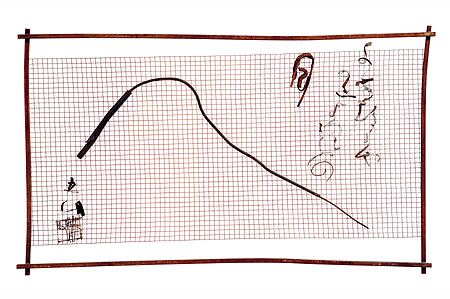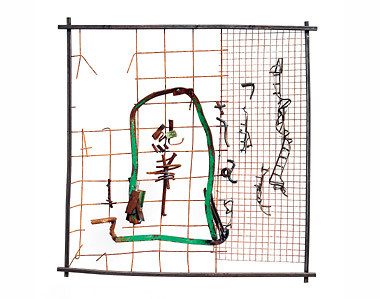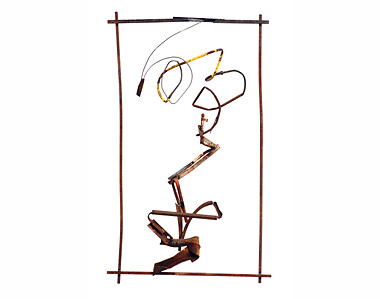 |
Dmitry Gutov. What's interesting is the stuff thrown away
An artist of international stature, Dmitry Gutov creates out of completely heterogeneous sources - the conceptual tradition, the search for a painterly language, intellectual studies, graphic design, Eastern calligraphy - an inimitable aesthetic alloy, an organic authorial amalgamation. His objects evoke the feeling of the live process of the birth of art. Gutov has fundamentally reinvented the subject of inquiry of Moscow Conceptualists - Soviet culture. Out of its ruins, he has extracted the legacy of the philosopher of art Mikhail Lifshitz and connected it to the future. Gutov's works can be found in the world's largest museums, and he participates regularly in the most important exhibitions of our time.
Alexander Evangely
|
 |
Born in 1960 in Moscow.
Graduated from Institute of Art, Sculpture and Architecture of the Academy of Arts, St. Petersburg.
|
|

Dmitry Gutov. Moon
Inoue Shiro, (1742-1812)
From the project In Search of Celestial Harmony. 2008
Welded metal, 120x200 cm
|
|

Dmitry Gutov. Monument to the Tip of the Brush
Gibon Sengai (1750-1837)
From the project In Search of Celestial Harmony. 2008
Welded metal, 100x100 cm
|
|

Dmitry Gutov. Untitled
From the project In Search of Celestial Harmony. 2008
Welded metal, 200x120 cm
|
|
|
|
Alexander Evangely: Dima, can one speak of a new stage in connection with your submission for the Russian Povera project?
Dmitry Gutov: It's a continuation of what I was doing for Documenta, a further development of an old project. I haven't added anything new in principle. I collect scrap metal that already reminds one of something and is then given slight finishing touches.
À.Å.: How important is their trash materiality?
D.G.: I came up with the whole thing looking at this rust. Everything that's rusty, dinted, bent. Well, plus the obsession with calligraphy.
À.Å.: You have already drawn these samples of handwriting, fonts, calligraphy; why did you feel the need to transfer it into a hard, brutal form?
D.G.: It's not just an issue of brutality. It's more about three-dimensionality. If you take all of my works over the span of many years, if you take old installations, shuttle-cocks on fishing line, etc., everything in them is premised on the existence of a certain three-dimensionality, a very dense space inside of which everything lives. Which is why when I work with canvas, it is important for me to dematerialize it, which I don't always manage. And here, it's the reverse. In space, the opposite is important - that in sunk relief, they become flat, so that there's this kind of game all the time, or, more accurately, a dramaturgy.
À.Å.: How interconnected is the movement of different themes? The themes of heaviness and lightness, calligraphy - they have their own dramaturgy, their own paths, they intertwine to form a work, in each work there manifests some sense of their interconnectedness. But how autonomous are these paths themselves?
D.G.: The pictorial and the metallic? The problem is that every time, there remains a kind of dissatisfaction that the needed synthesis has not been reached, which is why each time, a new form is sought out.
À.Å.: "Poor" is a word which carries not only material, but also ethical meaning. Your project, as I understand it, is charged with a similar ambiguity?
D.G.: As a basis, I took those poor, miserable fences in Kuzminki, my part of Moscow; they have interested me since I was a kid. In Soviet time, there was unsanctioned occupation of land lots, city-dwellers grew carrots there, onions, dill, and dragged all sorts of rubbish to their lots to use for enclosing and protecting them. It is their two- or three-meter high fences, which they put together by hand without welding instruments, and did it so you can't take those things apart - or enter, there's a lock hanging on the same kind of door. I saw this complicated interweaving as calligraphy.
|
 |
À.Å.: Can you understand the temptation with expensive materials?
D.G.: Sometimes, I have a certain amount of love for expensive materials; you know, an icon, for instance - covered in beaten gold, or something that is really well crafted. There is sometimes a desire for gold, diamonds - it lives within you…but I can't work with it for some reason, my heart is not in it. Especially with all those diamond skulls around. One wants something completely different. Besides, I can tell you that I've been interested in garbage dumps since childhood.
À.Å.: I don't get the feeling that you built your aesthetic out of an interest in garbage dumps.
D.G.: Well, I mean garbage dump not in a Kabakovian sense - not various rubbishy things… Do you remember, I once had an exhibition called The People Are Sly, where I showed a wooden fence; it was one of my early shows, before Art-Moscow there was something in the New Manezh. There, I put together a wooden fence that was falling apart. I am very interested in all that is decaying.
À.Å.: I don't find media images in what you do; magazines and TVs do not exist for you as reality. What does exist, then?
D.G.: Two things exist: real human life, these fences and the people who are fighting for their existence as best the can; and eternal classics exist. And between these two things there is nothing else.
À.Å.: What's amazes me is the stubborn instrumentalization of "poor" material, of trash. The insistence with which the artists claim that it's not really necessary when they say, "It's just a material with which it is convenient to work," - a statement which enters into a blatant contradiction with their entire aesthetic, built as it is on this material, and for which the material is obviously not accidental. I'm interested in the disconnect between that which artists claim and that which they do. What do you claim?
D.G.: I generally like everything pathetic, thrown away. The Lifshitz Museum, for example. I am interested in that which has been thrown out - in all regards, in its entirety.
À.Å.: In this sense, the people who build these fences turn out to be for you quite the aesthetic material, if you'll pardon my cynicism?
D.G.: Plus these bits of metal that they find. I just happen to love these themes and motifs. When a material is way overvalued - gold and diamonds, that sort of thing - I feel a profound inner sense of resistance. Which is to say, one can look at a statuette made of clay or at pieces made of gold or silver. My sympathies will always be on the side of clay or a piece of wood.
|
|
SELECTED SOLO EXHIBITIONS
2008 Used. M&J Guelman Gallery, Moscow
2006 For the Proper Movement of the Wrist. M. Guelman Gallery, Moscow
Thaw-Disgelo. Nina Lumer Gallery, Milan
Iteration, Return, Canon, Slowdown, Stupor. State Tretyakov Gallery, Moscow
2005 Everything I've Done Before the Age of 70 Doesn't Count. Guelman gallery, Moscow
The Deep Blue Colour Of His Skin Shows Just How Self-Absorbed He Is. Matthew Bown Gallery, London
Collective creativity, Kunsthalle Frider
|
|
 |